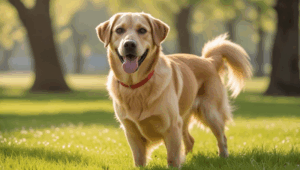Labrador Retriever Overview: History & Origin
History of Labrador Retriever
The story of the Labrador Retriever is more surprising than you might think. Despite the name, these iconic dogs didn’t actually come from Labrador. Instead, their roots are from the coasts of Newfoundland, Canada, where their ancestors, known as St. John’s dogs, worked alongside fishermen in the 1700s. Their webbed paws, strong tails, and weather-resistant coats made them perfectly suited for these jobs. These physical traits are just a few of the fascinating details about Labs, check out our Labrador Retriever Facts for more cool info about their unique features and history.
Origin of Labrador Retriever
By the 1800s, English nobles visiting Newfoundland were so impressed by the breed’s work ethic and charm that they brought some back to Britain. There, careful breeding evolved into an exceptional sporting and hunting companion, as well as a loyal family pet. The third Earl of Malmesbury was the first to call them “Labradors,” and the name stuck. Within decades, Labradors became beloved for both their gundog skills and their affectionate nature at home.
By the early 20th century, the Labrador Retriever dog was officially recognized by kennel clubs in England and the United States. The Labrador breed gained popularity and today, they are consistently one of the most popular dog breeds in the world.
It’s almost funny how a breed that once hauled fishing nets now hauls tennis balls, slippers, or whatever they can find around your house.
| Origin | Newfoundland (Canada) |
| First Called “Labrador” | Early 1800s (England) |
| Original Job | Fishermen’s helper, retriever |
| Modern Roles | Companion, service dog, search and rescue, therapy, sporting |
Physical Characteristics: Size, Appearance, Weight & Colors
So, what does a Labrador Retriever actually look like? Labs are medium to large-sized, making them the perfect “not too big, not too small” companion for many households. But let’s get specific, because there’s more to this breed than meets the eye.
Labrador Retriever Size and Weight
Most adult males weigh between 65-80 pounds, while females usually range from 55-70 pounds. Their height typically lands between 21.5 to 24.5 inches at the shoulder, depending on genetics and whether your Lab is of English or American lines.
- Body Shape: Labs have a broad skull, strong jaws, deep chest, and a muscular build, think of them as the canine version of a friendly athlete.
- Tail: Their signature “otter tail” is thick at the base and tapers at the end, covered in dense, short fur. It acts like a rudder in water and is almost always in cheerful motion.
Labrador Retriever Colors and Coat Genetics

Labs come in three classic colors: black, yellow, and chocolate. Each color can show subtle variations, yellow Labs range from pale cream to rich fox-red, while chocolate Labs can be light or dark.
- Black: The original lab color, sleek and shiny. Black lab puppies and adults are popular in working and show lines alike.
- Yellow: Ranging from pale cream to rich, deep gold. Some yellow Labs have darker “fox red” hues.
- Chocolate: From light milk chocolate to deep, dark brown. Chocolate labrador retrievers are especially prized for their unique look.
Occasionally, you’ll hear about white lab puppies, fox red labs, or even the rare “Dudley” labrador (with a pinkish nose). These all fall within the broad spectrum of labrador retriever dog breed colors. Read our article on Labrador Retriever Colors to know the different coat color variations. Only black, yellow, and chocolate are officially recognized by the American Kennel Club.
- Coat: The Labrador’s double coat is short, straight, and water-resistant. The undercoat keeps them warm, while the topcoat repels moisture and dirt, perfect for a dog who loves water and mud!
Personality and Temperament: What Makes Labradors Special
Friendly, goofy, and eager to please, those are just a few ways to describe Labrador Retriever temperament. Whether you’re having a great day or feeling down, your Lab will pick up on your mood and do their best to brighten it. Ever noticed how your dog waits by the door when you’re sad? That’s a Lab’s empathy in action!
I remember meeting my friend’s labrador named Max who would literally wag his whole body when guests arrived. Labs thrive on attention and companionship, often following their favorite humans from room to room. That said, their endless energy can be a handful if not channeled productively.
What sets Labradors apart?
- Affectionate: Labs love to be around family, kids, adults, other pets, even strangers. If you want a dog who greets guests with a wag instead of a bark, you’ve found your match.
- Intelligent: These dogs have brains to match their brawn. Quick to learn, eager to work, and always up for a new trick or puzzle.
- Patient and Gentle: Labs are famously tolerant with children. While supervision is always key, their good-natured patience makes them ideal family companions.
- Playful and Energetic: Labs never seem to lose their puppy-like enthusiasm. They crave activity, fetch, swimming, running, or just goofing around in the yard.
- Social Butterflies: Labradors thrive on companionship and hate being left out. They’re happiest when involved in every family adventure, from hiking to snuggling on the couch.
Still, Labs aren’t perfect. Their excitement can bowl over toddlers or the occasional unsuspecting guest. And their love of food, I would suggest, don’t leave snacks unattended! Labs are notorious kitchen counter surfers and will eat just about anything, edible or not.
Because they’re so people-oriented, Labs can be prone to separation anxiety if left alone for long periods. The good news? With proper training, socialization, and exercise, most of these quirks turn into endearing traits rather than problems.
Lab Care Essentials: Exercise, Grooming, and Daily Needs

So, you’re ready to give a Labrador Retriever the best life possible. What do they need on a daily basis? The answer: quite a bit! Labs are energetic, social, and strong-willed; they thrive with structure, activity, and lots of love.
Exercise Needs
- Daily Activity: Labs need at least 1 hour of exercise every day. This could be brisk walks, running, swimming, fetch, or agility games. A tired Lab is a happy (and well-behaved) Lab.
- Variety: Mix it up! Labs adore water, so swimming is a great way to burn energy. They also love hiking, scent work, and any game that involves retrieving.
- Mind Games: Don’t forget mental exercise. Puzzle toys, hide-and-seek, and training sessions keep their clever minds engaged.
Grooming
- Shedding: Labs shed, a lot. Their double coat “blows” twice a year, but you’ll find loose hair year-round. Brush two to three times weekly, and more during shedding season. A deshedding tool is your new best friend.
- Bathing: Every 1–2 months or as needed. Labs love mud, so be prepared for extra baths after big adventures.
- Ears: Check and clean their floppy ears regularly to prevent infections, especially after swimming.
- Nails: Trim every 3–4 weeks to prevent overgrowth and discomfort.
- Teeth: Brush several times a week, or provide dental chews to maintain oral health.
Learn the best ways to care for your dog’s coat and skin by visiting our Grooming Guide, where you’ll find tips on when and how to groom your furry friend.
Daily Care & Essentials
- Feeding: Labradors love to eat. Feed high-quality dog food formulated for large breeds, split into two meals per day. Watch their weight, obesity is a real risk for this food-loving breed.
- Water: Always provide fresh water, especially after exercise.
- Social Time: Labs crave company. Don’t leave them alone for long stretches, and involve them in family activities whenever possible.
- Safe Space: Labs can be mischievous, especially as puppies. Puppy-proof your home, provide chew toys, and crate train if needed.
Feeding Your Labrador: Nutrition, Diet Tips, and Common Food Issues
Labs are legendary food lovers. Their enthusiasm for mealtime is adorable, but it’s also a big reason why nutrition is one of the most important pieces of Lab care.
Let’s get real: Labradors are prone to weight gain, and obesity is a huge health risk for this breed. The secret to a healthy, tail-wagging Lab? Smart feeding, top-notch nutrition, and a little tough love when those big brown eyes beg for a snack.
What Should a Labrador Retriever Eat?
- Quality Protein: Look for dog foods with real meat, chicken, beef, fish, or lamb, as the first ingredient. Protein supports strong muscles for these active pups.
- Healthy Fats: Omega-3 and Omega-6 fatty acids (from fish oil or flaxseed) help maintain that signature shiny Lab coat and support joint health.
- Complex Carbohydrates: Brown rice, sweet potatoes, and oats provide energy and fiber, keeping digestion on track.
- Vitamins and Minerals: Labs need a balanced mix of nutrients for immunity, bone health, and overall well-being. Look for foods approved by the AAFCO (Association of American Feed Control Officials).
Puppies, adults, and seniors have different needs. Lab puppies should eat a large-breed puppy formula until about 12 months old; this controls their rapid growth and helps prevent joint issues. Adults do well with large-breed adult formulas, watch those calories! Senior Labs may need fewer calories but extra joint support. Always consult your vet for the best plan.
| Life Stage | Feeding Tip |
| Puppy (up to 12 months) | Large-breed puppy formula for steady growth |
| Adult | High-quality adult food, split meals twice daily |
| Senior (7+ years) | Lower-calorie diet to avoid weight gain |
How Much to feed a Labrador Retriever?
- Portion Control: Labradors are foodies. Stick to measured portions based on your dog’s age, weight, and activity level. Overfeeding, even a little, can add up fast.
- Meal Frequency: Twice a day is best for most adult Labs. Puppies may need three meals until they’re about six months old, then transition to two.
- Slow Feeders: Labs eat quickly, sometimes too quickly. Slow-feeder bowls can prevent bloating, choking, and upset stomachs.
Here’s a quick example feeding chart for a healthy adult Lab (always adjust based on your vet’s advice):
| Weight | Daily Food Amount (Cups) |
| 55 lbs (25 kg) | 2.5–3 |
| 70 lbs (32 kg) | 3–3.5 |
| 80 lbs (36 kg) | 3.5–4 |
*For reference only. Calorie content and needs vary by food and activity level. Check out our Labrador Feeding Guide to understand how much food your lovable pet needs for a healthy and happy life.
Common Food Issues in Labs
- Obesity: Labs are notorious for packing on pounds. Keep treats to a minimum (no more than 10% of daily calories), say no to table scraps, and monitor body condition regularly. A fit Lab should have a visible waist and you should be able to feel, but not see, the ribs.
- Allergies: Some Labradors develop food sensitivities, showing up as itchy skin, ear infections, or stomach upset. If you notice these, talk to your vet about an elimination diet or allergy testing.
- Bloat: Though not as common as in some breeds, Labs can develop bloat (gastric dilatation-volvulus). Feeding smaller, more frequent meals and using slow feeders can help reduce the risk.
- Scavenging: Labs will eat socks, rocks, or anything remotely food-like. Puppy-proof your home, supervise closely, and train a rock-solid “leave it” command!
Supplements for Labrador Retriever
If your Lab is eating a complete, balanced commercial food, supplements aren’t usually needed. However, dogs with joint problems may benefit from glucosamine, chondroitin, or fish oil, always check with your vet first.
Thinking about home-cooked or raw diets? It’s doable, but requires careful planning and veterinary guidance to make sure your Lab gets everything they need
The way to a Lab’s heart is through their stomach, but the way to a long, healthy life is through smart, measured feeding. Keep your Lab lean, happy, and full of energy, just maybe not too full!
Training and Socialization: Raising a Well-Behaved Lab
If you want to see just how smart, stubborn, and eager-to-please a dog can be, all at once, try training a Labrador Retriever puppy! Labs are famous for their intelligence and energy levels but without guidance it can turn into chaos. But with the right approach, you’ll have a superstar companion who’s a joy to live with.
Start Early, Stay Consistent
The earlier you start training and socializing your Lab, the better. Lab puppies are like sponges, soak them in positive experiences, and you’ll set the stage for a confident, polite adult dog. But don’t worry if your Lab is older; these dogs are lifelong learners.
- Basic Commands: Sit, stay, come, down, and “leave it” are non-negotiable. Labs are smart and usually learn quickly, especially when treats or praise are involved.
- Positive Reinforcement: Labs respond brilliantly to rewards, treats, toys, or enthusiastic praise. Avoid harsh corrections; you’ll get much further with patience and encouragement.
- Short Sessions: Young Labs have short attention spans. Keep training fun and brief (5–10 minutes at a time), with lots of play breaks.
- Consistency: Use the same cues and routines. Labs are creatures of habit and thrive on knowing what’s expected.
Socialization: The Secret Ingredient
Expose your Lab puppy to different people, places, animals, sounds, and experiences, gently and positively. Invite friends over, take safe walks in the neighborhood, and let your pup meet friendly dogs. (Don’t forget to supervise all interactions, especially with kids or other pets!)
- Household Rules: Set boundaries early. Teach your Lab what’s okay to chew (toys, not shoes!), where to potty, and how to greet visitors politely.
Common Training Challenges (and How to Fix Them)
- Jumping Up: Labs love people and often show it by leaping up. Teach an alternative like “sit for greetings” and reward calm behavior.
- Mouthing and Chewing: Lab puppies explore with their mouths. Provide plenty of chew toys, supervise, and redirect gently when they grab something off-limits.
- Pulling on Leash: Labs are strong! Start leash training early, using a front-clip harness if needed. Reward loose-leash walking and stop if your dog pulls.
- Barking: While not usually excessive, Labs may bark for attention. Ignore unwanted barking and reward quiet.
Labrador Retriever Lifespan & Common Health Issues
The typical Labrador Retriever lifespan is 10 to 13 years, though some “lab dog” companions live even longer with great care. Like all breeds, Labs have a few health concerns to watch for:
Most Common Health Problems
- Hip and elbow dysplasia: Joint disorders leading to pain or arthritis.
- Obesity: Labs love food and are at risk for weight gain.
- Progressive retinal atrophy (PRA): An eye disease causing vision loss.
- Ear infections: Their floppy ears can trap moisture and debris.
- Exercise-induced collapse (EIC): A genetic disorder causing weakness after intense activity.
Prevention Tips
- Choose a reputable breeder who tests for genetic diseases.
- Keep your lab at a healthy weight with proper diet and exercise.
- Schedule regular vet checkups and vaccinations.
- Clean ears weekly and keep them dry after swimming.
- Monitor for signs of lameness or eye changes.
Recommended Health Screenings
| Test | Purpose |
| Hip/Elbow Evaluation | Detects joint problems |
| Eye Exam | Checks for PRA and cataracts |
| Genetic Testing | Identifies EIC and other inherited diseases |
For in-depth labrador breed health information, read our article on labrador health issues.
FAQs About Labrador Retrievers
How long do Labrador Retrievers live?
Most Labrador Retrievers live 10 to 13 years, with some reaching 14 or more with excellent care, regular exercise, and good nutrition. Genetic factors and proactive health checkups play a big role in longevity.
Are Labrador Retrievers good for families with children?
Absolutely! Labrador Retrievers are famously patient, loving, and gentle with kids. Their playful energy and affectionate temperament make them one of the best dog breeds for families. Always supervise interactions with small children, just in case.
Do Labradors shed a lot?
Yes, Labrador Retrievers are considered heavy shedders, especially during seasonal changes. Regular brushing and a healthy diet can minimize loose hair, but expect to find some fur around the house year-round.
What are the main health issues in Labrador Retrievers?
Labs are prone to hip and elbow dysplasia, ear infections, obesity, progressive retinal atrophy, and occasionally exercise-induced collapse or certain cancers. Routine vet checkups and maintaining a healthy weight help manage these risks.
What’s the difference between English and American Labs?
English Labs are typically stockier, with blockier heads and a calmer demeanor, while American Labs are taller, leaner, and bred for fieldwork, giving them higher energy. Both are loving and loyal!
How much exercise does a Labrador Retriever need?
Labradors need at least an hour of exercise every day, sometimes more. Walks, runs, swimming, and games like fetch are great for both their body and mind.
Is a Labrador Retriever right for a first-time dog owner?
Often, yes! Labs are friendly, trainable, and eager to please. Just be ready for their high energy, need for daily activity, and the commitment to grooming and training. With time and love, Labs reward you in spades.
Conclusion
The labrador retriever is one of the world’s most loved dog breeds for good reason. Whether you’re seeking a loyal family pet, an energetic companion for outdoor adventures, or a trainable dog for therapy or service work, the lab retriever dog truly excels.



